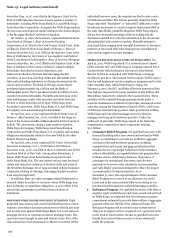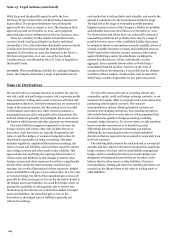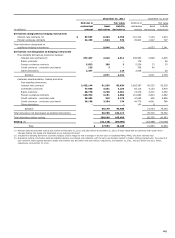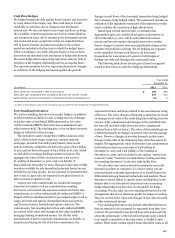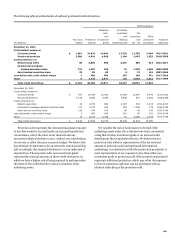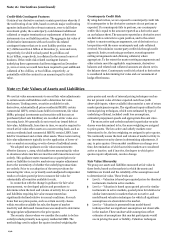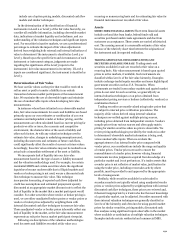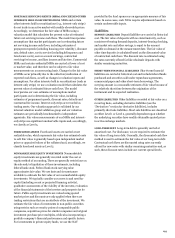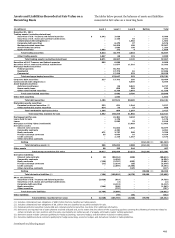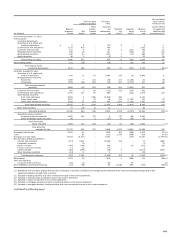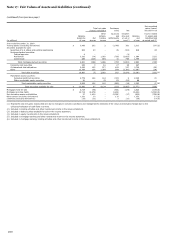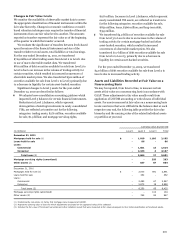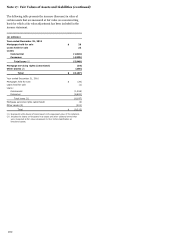Wells Fargo 2011 Annual Report Download - page 194
Download and view the complete annual report
Please find page 194 of the 2011 Wells Fargo annual report below. You can navigate through the pages in the report by either clicking on the pages listed below, or by using the keyword search tool below to find specific information within the annual report.Note 17: Fair Values of Assets and Liabilities (continued)
municipal bonds, U.S. government and agency MBS, and
corporate debt securities.
Security fair value measurements using significant inputs
that are unobservable in the market due to limited activity or a
less liquid market are classified as Level 3 in the fair value
hierarchy. Such measurements include securities valued using
internal models or a combination of multiple valuation
techniques such as weighting of internal models and vendor or
broker pricing, where the unobservable inputs are significant to
the overall fair value measurement. Securities classified as Level
3 include certain residential and commercial MBS, asset-backed
securities collateralized by auto leases or loans and cash
reserves, CDOs and CLOs, and certain residual and retained
interests in residential mortgage loan securitizations. CDOs are
valued using the prices of similar instruments, the pricing of
completed or pending third party transactions or the pricing of
the underlying collateral within the CDO. Where vendor or
broker prices are not readily available, management's best
estimate is used.
MORTGAGES HELD FOR SALE (MHFS)
We carry substantially all
of our residential MHFS portfolio at fair value. Fair value is
based on independent quoted market prices, where available, or
the prices for other mortgage whole loans with similar
characteristics. As necessary, these prices are adjusted for typical
securitization activities, including servicing value, portfolio
composition, market conditions and liquidity. Most of our MHFS
are classified as Level 2. For the portion where market pricing
data is not available, we use a discounted cash flow model to
estimate fair value and, accordingly, classify as Level 3.
LOANS HELD FOR SALE (LHFS)
LHFS are carried at the lower of
cost or market value, or at fair value. The fair value of LHFS is
based on what secondary markets are currently offering for
portfolios with similar characteristics. As such, we classify those
loans subjected to nonrecurring fair value adjustments as
Level 2.
LOANS
For the carrying value of loans, including PCI loans, see
Note 1. Although most loans are not recorded at fair value on a
recurring basis, reverse mortgages, which were previously sold
under a GNMA securitization program and were consolidated
during fourth quarter 2011, are held at fair value on a recurring
basis. In addition, we record nonrecurring fair value adjustments
to loans to reflect partial write-downs that are based on the
observable market price of the loan or current appraised value of
the collateral.
We provide fair value estimates in this disclosure for loans
that are not recorded at fair value on a recurring or nonrecurring
basis. Those estimates differentiate loans based on their
financial characteristics, such as product classification, loan
category, pricing features and remaining maturity. Prepayment
and credit loss estimates are evaluated by product and loan rate.
The fair value of commercial loans is calculated by
discounting contractual cash flows, adjusted for credit loss
estimates, using discount rates that reflect our current pricing
for loans with similar characteristics and remaining maturity.
For real estate 1-4 family first and junior lien mortgages, fair
value is calculated by discounting contractual cash flows,
adjusted for prepayment and credit loss estimates, using
discount rates based on current industry pricing (where readily
available) or our own estimate of an appropriate risk-adjusted
discount rate for loans of similar size, type, remaining maturity
and repricing characteristics.
The carrying value of credit card loans, which is adjusted for
estimates of credit losses inherent in the portfolio at the balance
sheet date, is reported as a reasonable estimate of fair value.
For all other consumer loans, the fair value is generally
calculated by discounting the contractual cash flows, adjusted
for prepayment and credit loss estimates, based on the current
rates we offer for loans with similar characteristics.
Loan commitments, standby letters of credit and commercial
and similar letters of credit generate ongoing fees at our current
pricing levels, which are recognized over the term of the
commitment period. In situations where the credit quality of the
counterparty to a commitment has declined, we record an
allowance. A reasonable estimate of the fair value of these
instruments is the carrying value of deferred fees plus the related
allowance. Certain letters of credit that are hedged with
derivative instruments are carried at fair value in trading assets
or liabilities. For those letters of credit fair value is calculated
based on readily quotable credit default spreads, using a market
risk credit default swap model.
DERIVATIVES
Quoted market prices are available and used for
our exchange-traded derivatives, such as certain interest rate
futures and option contracts, which we classify as Level 1.
However, substantially all of our derivatives are traded in over-
the-counter (OTC) markets where quoted market prices are not
always readily available. Therefore we value most OTC
derivatives using internal valuation techniques. Valuation
techniques and inputs to internally-developed models depend on
the type of derivative and nature of the underlying rate, price or
index upon which the derivative's value is based. Key inputs can
include yield curves, credit curves, foreign-exchange rates,
prepayment rates, volatility measurements and correlation of
such inputs. Where model inputs can be observed in a liquid
market and the model does not require significant judgment,
such derivatives are typically classified as Level 2 of the fair
value hierarchy. Examples of derivatives classified as Level 2
include generic interest rate swaps, foreign currency swaps,
commodity swaps, and certain option and forward contracts.
When instruments are traded in less liquid markets and
significant inputs are unobservable, such derivatives are
classified as Level 3. Examples of derivatives classified as Level 3
include complex and highly structured derivatives, certain credit
default swaps, interest rate lock commitments written for our
residential mortgage loans that we intend to sell and long dated
equity options where volatility is not observable. Additionally,
significant judgments are required when classifying financial
instruments within the fair value hierarchy, particularly between
Level 2 and 3, as is the case for certain derivatives.
192


